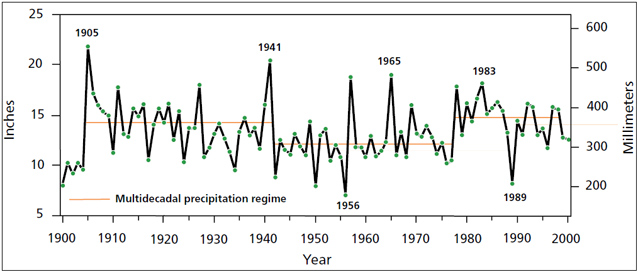While climate in the Southwest has fluctuated over time, sometimes substantially, it is now subject to an exceptionally rapid rate of increase in global temperatures compared with historical conditions.
Past climate

Not only is the climate of the Southwest variable across the landscape, but it has varied substantially across years, decades, and centuries, as well. The instrumental record, which covers about the past 100 years, shows that average temperatures and precipitation amounts have swung back and forth between years. For example, in 1941 the Colorado Plateau received over 20 inches of rain, but the next year it received less than 10. The instrumental record also shows that during the 20th Century, the Southwest experienced extended dry and wet periods. For example, while the period between 1905 and 1930 was unprecedently wet (Sheppard et al. 2002), the period between 1942 and 1956 was very dry.
To understand the full range of natural climate variability in the Southwest, scientists use several types of proxy records— mainly tree-ring records—to extend the climate record back thousands of years. Annual tree-rings grow in proportion to the amount of summer precipitation, so tree-ring records are used throughout the Southwest to reconstruct past dry and wet periods. The tree-ring records show that although past droughts were of about the same severity and affected the same amount of land area as droughts in the instrumental record, these past droughts lasted for much longer (Herweijer et al. 2007). One of these droughts was centered around AD 1150 (Cook et al. 2004, Ni et al. 2002, Salzer and Kipfmueller 2005). Another widely recorded drought occurred in the late 1200s and lasted for several decades (Grissino-Mayer 1996, Ni et al. 2002). Scientists have speculated that this drought was responsible for the collapse of the Ancient Puebloan culture in the region, but this hypothesis is now hotly debated (Woodhouse 2004).
Global climate change
The Intergovernmental Panel on Climate Change (IPCC), the group of scientists who issue comprehensive assessments on climate science and were awarded the 2007 Nobel Peace Prize for their work, reports that warming of the earth is unequivocal and that most of the increase in global temperature since the mid-twentieth century is very likely due to an increase in greenhouse gas concentrations (IPCC 2007). Using a range of scenarios for future greenhouse gas emissions and concentrations in the atmosphere, the IPCC has predicted a global temperature rise of 2 to 11.5 degrees Fahrenheit by 2099 (Jansen et al. 2007). Although the earth has been warmer in the geological past than its current temperature, global temperatures are currently rising at an exceptionally rapid rate relative to the rate that global temperatures have risen during other times in the geological record (Jansen et al. 2007). Over the next 90 years, temperatures are projected to rise by the same amount that they rose over a 5,000 year period coming out of the last Ice Age (Jansen et al. 2007). In addition, the current concentration of carbon dioxide (a major greenhouse gas) in the atmosphere is at a record high for the past half-million years (Jansen et al. 2007).
Part of a series of articles titled Climate Change in the Southwest.
Last updated: August 14, 2017
